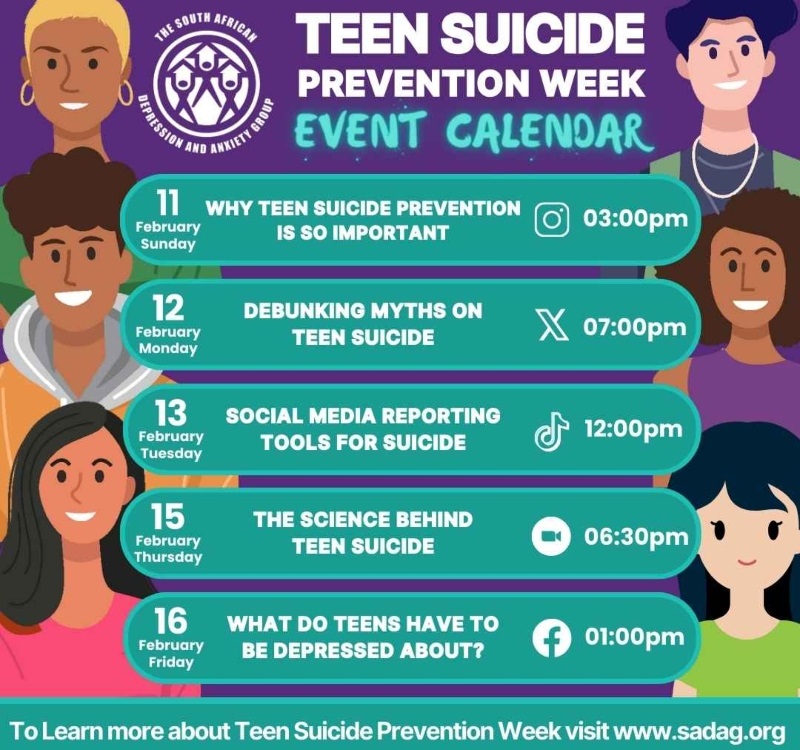
He was supposed to be preparing for his end-of-year exams and should have been excited about the prospect of starting high school.
Instead, the 14-year-old from Cape Town felt so hopeless that he committed suicide, seemingly because he was teased for being a slow learner – another young life cut short because the world felt too alien and frightening a place.
“Talking about hard topics like suicide helps to create open conversation, foster safe spaces for young people to talk openly about their struggles, and identify warning signs to get help," according to South African Depression and Anxiety Group (SADAG) Operations Director Cassey Chambers.
"As parents, caregivers, teachers and communities – we need to talk more about the issues and normalise that it’s okay to reach out for help.”
"Teen Suicide Prevention Week (11-18 February) is an invaluable opportunity to dismantle stigma, give empathy, and equip our communities with the resources they need to address this urgent issue," explains Dr Frans Korb, Psychiatrist, Psychologist & SADAG Board Member.
"By encouraging open conversations, providing accessible support networks, and promoting early intervention, we can make significant strides in saving lives and safeguarding the well-being of our youth.”
Read more | 'Tik was a hiding place for me' - Former addict Mihle Zethu Dini on why she's helping others beat addiction
There is a link between depression and suicide.
"It is not hard to see why serious depression and suicide are connected. Depression involves a long-lasting sad mood that doesn't let up and a loss of pleasure in things you once enjoyed. It Involves thoughts about death, negative thoughts about oneself, a sense of worthlessness," according to SADAG founder Zane Wilson
TEENS AT RISK
"When it comes to suicide among teenagers, the most common age is 14 to 19," Cassey recently told 702.
About one in four teenagers have "at some stage thought about taking their own life or felt hopeless and helpless".
WHAT IS GOING ON?
While the reasons someone takes their own life are always complex, experts believe a rise in teen suicide is linked to the uncertain times we live in. Children born in the first years of the 21st century have been raised in an era of economic insecurity, and have never known a time when terrorism wasn’t the norm, an article in TIME magazine on teen anxiety and depression says.
Today’s teenagers are also reaching puberty at a time when technology and social media are transforming society and the way people interact. Adolescents are at a stage where they’re trying to find their place in the world, their emotions and reactions are intense and the social climate that they’re living in is very different to what it was just 10 years ago.
“If you wanted to create an environment to churn out really angsty people, we’ve done it,” says Janis Whitlock, a research director at Cornell University in the US. Teenage angst is certainly not new. But what is new is that never before has a generation faced so much pressure in the glare of social media. Because of the scrutiny of constantly being on display, what should be a time full of promise and possibility has become one of intense pressure – not only to fit in but to standout and impress.
THE PROBLEMS WITH SOCIAL MEDIA
The fishbowl effect of social media is definitely a contributing factor to the rise in teen depression and anxiety, says Liane Lurie, a Joburg clinical psychologist. She explains some of the problems:
- It’s an adult-free zone
Liane believes the danger of teen obsession with social media platforms lies in the fact that it’s a relatively adult-free space. That, of course, is exactly its appeal. Social media allows teens to connect with each other, create their own online circles or communities– and keep adults out. But the flipside of that is the lack of a moderating presence at a time when it’s most needed.
Read more | ‘Once a person has decided to commit suicide, they start behaving out of character’ – expert
“Adolescents are especially prone to impulsivity and acting out,” Lurie says. “In this boundary-less online world they boldly type out messages, unable to seethe impact on their intended victim. They may not realise they’ve created a permanent – and possibly viral – record of shame and hate for all to see.”
- Teens are prone to overload
A joint study by the University of California and the University of Texas into the social media usage of 13-year-olds found “there’s no firm line between their real and online worlds” for these kids.
Social media allows us to connect with people all over the world in an instant, but this “hyper-connectedness” has also led to young adults being overexposed. It’s possible for every little fight and slight that happens in their world to be “documented online for hours or days after the incident”, TIME states.
“They’re in a cauldron of stimuli they can’t get away from, or don’t want to get away from, or don’t know how to get away from,” says Whitlock.
- Bullying and peer pressure
“There’s increasing evidence that cyberbullying and social media can influence suicide-related behaviours,” says Tamara Zanella, a counselling psychologist from Johannesburg. “And it can be more complicated to deal with than in-person bullying.”
“When teenagers experience emotional discomfort – such as the feeling of intense shame after cyberbullying – it can be overwhelming,” says Tyrone Edgar, another Joburg psychologist.
“If the teen can’t see a way out, suicide can sometimes seem like a means to find ‘relief ’. The stigma surrounding mental illness only serves to make the problem worse, Zanella adds. No teenager wants to be seen as flawed or vulnerable, especially when everyone else’s life looks so great on social media.
WHAT PARENTS CAN DO
So what can parents do to help? And how can you tell if your child is in a situation where they feel they have no way out?
It all comes down to staying connected with your child. Social media makes the teenage years even more challenging because it’s so easy for kids and parents to disconnect even when they’re in the same room.
- Be at home at home, not at work
Technology has also made it possible for work time to encroach on home time for adults, the TIME article points out. “You’re never away from work now,” says one father who was shocked to discover his daughter was battling anxiety and had been cutting herself for years.
“Before, there wasn’t anything [work-related] to worry about till I got back [to work] on Monday. But now you’re always on your phone. Sometimes even when you’re home, you’re not home.”
- Keep communication open
Make sure there are times when you and your teenager just talk so you get an idea of what’s going on in their lives, Edgar says. Teenagers need to feel that their parents are available even while they’re developing a sense of independence. It’s important to remember that frequent everyday interactions can build closeness, just as much as scheduled time together can.
- Offer guidance with social media
Parents also need to talk to their teens about the problematic side of social media and how it can affect the way they feel about themselves.
Establish rules about how to engage with others on social media, Zanella advises. “For example, parents should explain to their teens that they shouldn’t share anything that could hurt or embarrass themselves or others. Remind them that once something has been posted, they have no control over who shares it.”
Contact SADAG’s toll-free Suicide Helpline on 0800 567 567 or 0800 21 22 23 or SMS 31393, and a counsellor will call back. Visit www.sadag.org for more information and resources.
Extra sources: www.iol.co.za/capetimes, www.who.int, Time Magazine, dailymail.co.uk, dailyvoice.co.za, capetalk.co.za, explainthatstuff.com, Cape Times




















